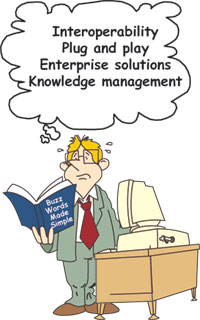Drilling advances
IT buzzwords find a home in drilling. We've been using computers and software in drilling applications for a long time. Examples include developing a directional well plan, transmitting LWD and directional information, and measuring parameters, such as pump pressure, hookload or flow rate. However, most applications were developed and designed for stand-alone usage, rather in an integrated platform. Only recently, as information technology (IT) has become a part of our work day lives, have the applications come together, to drill wells faster and more efficiently. With the emergence of, and subsequent dependence on IT has come its complete merger with drilling. Methods and techniques once exclusive to IT are now incorporated into drilling. Buzz-words spawned by IT are appearing in discussions between drilling engineers, managers and R&D groups. Given this month's feature on information technology issues, I thought it would be interesting to look at some words and phrases that found their start in the IT sector and see how they apply to drilling.
Interoperability. This term refers to a system's or product's ability to work with other systems and products. Interoperability is important when exchanging information between systems, or when storing it in a database. For instance, LWD information from one provider may need to be combined with mud logging information from another provider. Historically, transferring data and information from one service company to another often required converting the files to different formats or processing data to appear in a different way. With the advent of the WITSML standard (described on pg. 57), information coming from different service providers adheres to the same definition, making data processing, interpretation and storage much more efficient. Plug-and-play. This feature allows users to plug a device into a computer and have it recognize the device. Plug-and-play has advanced the development cycle for LWD and wireline logging tools by allowing developers to write software code in modules, and use each module for multiple sensors, much like a desktop computer's operating system. Kirk Towns, project coordinator for Precision Energy Services' LWD tool development group, says such techniques have drastically reduced time-to-market for new downhole logging tools. “We've developed a central controller, so we don't have to upgrade firmware or retest every software component each time a sensor is enhanced. By using a generic software module and relying on definable parameters set by the surface software, downhole tools are easier to commercialize, and have greater reliability.” Enterprise solutions are software systems that support and automate business processes in large companies. Oil and gas firms are adopting enterprise solutions to run applications from drilling to production, to well and field management – a life cycle solution. Some of the most comprehensive software began as much smaller applications. For example, Peloton's WellView system was designed in the early 1990s to draw data-generated wellbore schematics. But, says Peloton product manager Gary Jacques, “In the late 1990s, WellView evolved to include drilling, completion and operational reporting, allowing data entry closer to the source. The newest version of WellView includes well testing, geological and production data providing a much more complete well information system.” Greatest benefits are obtained when an enterprise system is adopted company-wide. Jacques adds, “The breadth of WellView's scope has users from drilling, completions, well ops, land, permitting, production, reservoir, geology, accounting and management accessing it. In one client's operation, WellView is the second most accessed software, only after the accounting system.” Similarly, Landmark Graphics' Engineer's Data Model (EDM) provides a single database for many drilling programs. According to Sheldon Harbinson, Landmark's Market Development Director for Drilling and Well Service Systems, “EDM provides drilling engineers and managers a common platform to work from when completing morning reports or running applications, like torque and drag analysis, hydraulics calculations and other programs used during well construction. Information stored in EDM's database can be used to make real-time decisions by comparing planned vs. actual drilling parameters, or for technical limit analysis planning.” Knowledge management. Knowledge management allows companies to gather, organize and share information between teams and across geographical boundaries. It also ensures that this information will not be lost over time, and can be easily recalled, referenced or employed. As operators continue downsizing workforces, knowledge management practices become increasingly important for retaining valuable information about how to drill wells in different areas. Knowledge management helps companies make better, faster decisions by documenting successful practices and learning from failures. So, perhaps, we have learned something about drilling from the IT folks. These four buzzwords may not be commonplace in a driller's vocabulary yet, but the benefits provided by each method and technique are helping to make the drilling of simple wells easier, and the drilling of challenging wells possible.
|
|||||||||
- Coiled tubing drilling’s role in the energy transition (March 2024)
- Using data to create new completion efficiencies (February 2024)
- Digital tool kit enhances real-time decision-making to improve drilling efficiency and performance (February 2024)
- E&P outside the U.S. maintains a disciplined pace (February 2024)
- Prices and governmental policies combine to stymie Canadian upstream growth (February 2024)
- U.S. operators reduce activity as crude prices plunge (February 2024)
- Applying ultra-deep LWD resistivity technology successfully in a SAGD operation (May 2019)
- Adoption of wireless intelligent completions advances (May 2019)
- Majors double down as takeaway crunch eases (April 2019)
- What’s new in well logging and formation evaluation (April 2019)
- Qualification of a 20,000-psi subsea BOP: A collaborative approach (February 2019)
- ConocoPhillips’ Greg Leveille sees rapid trajectory of technical advancement continuing (February 2019)





